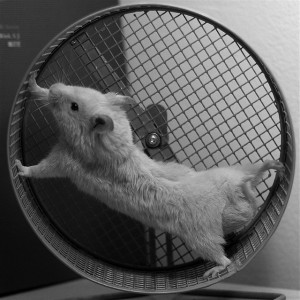I once thought of corrective exercise as a magic ritual that would instantly fix pain. I believed a Z-Health drill, an FMS glute bridge, NSCA balance exercise, exotic kettlebell move, or some specific stretch or core activation routine would instantly change something so that I could move freely without pain—and without thinking about it. That’s magical thinking and now I think otherwise.
Corrective exercise is only corrective if the movement skills or sensations learned during the exercise transfers to the “real-life” activity for which the correction is sought. This process entails diligent thinking and crucially, it requires awareness. A corrective exercise should promote awareness of how to use certain muscles and/or how to move or stabilize a limb in a new, more effective way. Here’s an example:
At a recent running-related clinic conducted by running coach and physical therapist Jay Dicharry. we discussed a common problem among runners in which forward propulsion comes from too much lumbar spine extension and not enough hip extension. This is inefficient and may cause low-back pain, knee pain, and other problems. We learned several strategies to run in neutral posture while extending the hip. More specifically, we used the abs to bring the ribs down toward the pelvis, reducing lumbar extension, while simultaneously contracting the glutes to drive the leg backward. Several exercises helped us gain awareness of glute contraction, hip extension, and ribcage positioning. We didn’t stop with exercises. We took the awareness created by the exercises to the act of running. We had to think and pay close attention to what we were doing.
In the context of corrective exercise, my job is to facilitate habit change in my clients. I must select the exercises that help my client move and feel better. The exercises should have adequate similarity to the activity in which my client wants to improve. I must use cues that resonate with my client, that help them understand and feel the proper movement pattern.
This process may require using several exercises that link to the activity itself. For running, we may start with a simple exercise to simply feel a muscle, the glutes for example. We may start with some sort of bridge, lying supine on the ground. We may progress from lying on the ground to kneeling, to standing on two legs to standing on one leg, and then to running. All the while, I must use the right cues and instructions to keep the client focused on the task at hand. Finally, I must ensure my client repeats the new movement pattern. Repetition is essential for learning.
The corrective exercise process is fundamentally about habit change. It’s about focused learning to create and allow new, different movement. The new movement process must be practiced and ingrained so that it replaces the old, painful movement. Corrective exercise is not about an automatic fix.

